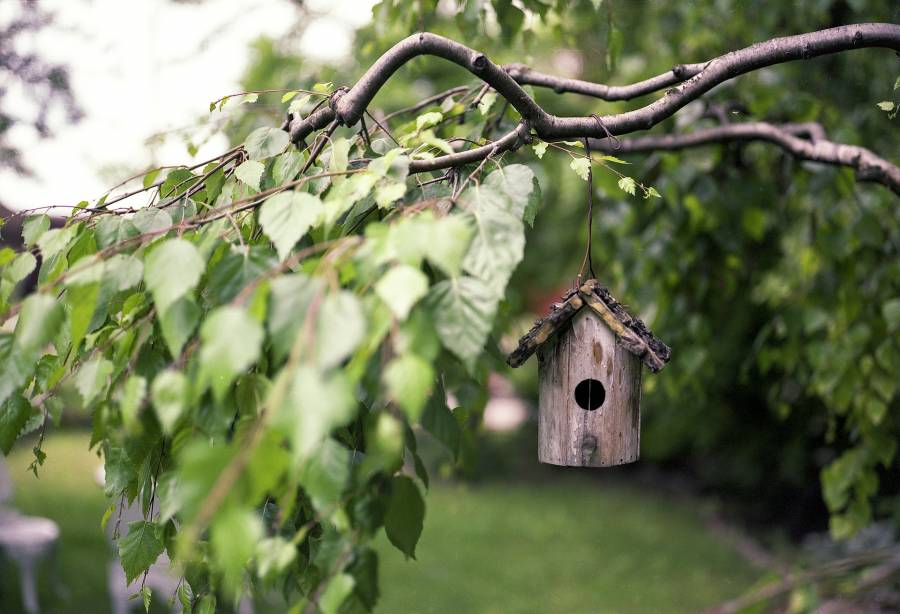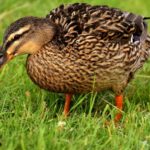Quick Navigation
Bird feeding is an exciting hobby that allows you to photograph and observe avian wildlife while also helping them survive harsh winters, but do you have complete knowledge or a guide on cleaning bird feeders?
However, merely setting up the bird feeders and abandoning them would be very irresponsible; the birds may become unwell if they are not cleaned regularly.

Cleaning bird feeders can be a daunting task.
Bird feeders require regular maintenance since routinely cleaned feeders usually last longer.
Therefore, they must be cleaned and sterilized regularly.
It could be every two weeks or even more frequently if possible.
Avian pox, mycoplasmal conjunctivitis in house finches, salmonellosis (caused by salmonella), and aspergillosis are just a few diseases that birds can spread through feeders (a fungal respiratory disease).
How Often Should You Clean Bird Feeders?
The frequency mainly depends on the type of feeder you have; therefore, you should stick to a schedule suitable for that type.
If you don’t clean your bird feeders as often as you should, molds and contaminants may develop.
However, you can keep your birds healthy by washing your ground feeders every other day.
This is mainly due to its proximity to the ground; hence, it must be cleaned often.
If you have hanging feeders, you can clean them every other week since it is just hanging mid-air, away from any ground contaminants.
If you have a feeder for hummingbirds, you must clean it daily to prevent bacteria from growing off the sugars in the feeder.
For the bird droppings, you must remove them regularly.
In the same way, frequency also depends on your weather condition and bird activity around your area.
So, if you live in a damp climate or experience constant and heavy downpours, you must clean the bird feeder at least twice as often.
Here’s how to keep your feeders in good shape.
List of Supplies You Will Need To Clean Your Bird Feeder
- Gloves
- Tubs/large bowls
- Dish soap
- Tube brushes
- Scrub brushes (Nature stores and garden centers have specialized brushes)
- Rags
- Bleach or Vinegar (Bleach is the better option, if available)
- Measuring cup
- A supply of water
The cleaning steps are as follows:
1. Emptying And Disposing
The first step when you clean bird feeders is to remove all leftovers and birdseed from the feeder.
It is often advisable to dispose of the seeds, especially if wet, into a disposal bag or trash bag.
However, the seeds may sprout if not properly disposed of or littered.
Also, avoid scattering seeds because they attract rodents, such as chipmunks, squirrels, and mice, which can attract stray cats, snakes, and hawks that may prey on the birds at the feeders.
2. Soaking And Loosening
Bird leftovers and droppings can be removed by soaking the feeders in warm water with mild soap; boiling water is best advised.
Bird dropping can be sticky; a degreasing dish soap will dissolve it.
Soak the feeder for at least 15 minutes and up to an hour; this helps loosen any seed and dissolve sticky droppings or debris lodged in the bottom.
Before soaking, it’s a good idea to take the feeders apart.
Getting feeders that can be dismantled is a good idea because it makes cleaning more accessible and thorough.
3. Scrubbing And Rinsing
To properly clean your bird feeders, scrub all the feeding surfaces with a brush after soaking the feeders to remove any seed, dirt, or waste.
A bottle brush or a tube feeder brush with tube feeders is best advisable.
If you have long tube feeders, invest in a feeder brush explicitly made for that length.
These are available from reputable bird feeder retailers and are well worth the money.
After washing with a mild water spray, thoroughly rinse the feeders and inspect for any leftover material.
Repeat the soaking and scrubbing steps until all of the dirt is gone.
Then, rinse well to remove any loose feed or debris.
If you’re going to rinse with a hose, be careful because parts that have been weakened can be destroyed by powerful water jets.
4. Disinfecting And Sterilizing
After proper cleaning and rinsing, the bird feeders must be disinfected and sterilized.
Soak the bird feeder in a 50-50 vinegar-water solution, or prepare a bleach-to-water solution using one-part bleach to nine-parts water.
Scientists recently discovered how to find an effective approach to minimize Salmonella bacteria levels on bird feeders.
They discovered that when a bird feeder is soaked in bleach or vinegar, it reduces Salmonella bacteria more effectively than cleaning with soap and water.

When they experimented with soap and water, the feeders still had enough salmonella to spread the disease.
Cleaning solutions for commercial bird feeders are also helpful.
After disinfection, rinse thoroughly.
And after rinsing, there should be no sticky dirt, soap suds, or chemical odors.
5. Drying The Feeders
After you clean the bird feeders, drying is next (preferably sun drying), then reassembling and refilling.
Sun drying is preferable because it alleviates and dries moisture, leading to mold and mildew that can cause various illnesses.
Sun drying also helps break down lingering soap and chemicals while killing extra bacteria as a bonus.
Mesh feeders dry quickly, but tube feeders may need a day or two to dry fully.
Turn the feeders over to make sure no water remains.
Also, clean up the space around and under the feeders while they dry.
Clean up spilled seeds and husks using a rake.
Keeping the ground beneath feeders clean is critical to deter unwelcome visitors (rodents) and prevent sickness.
6. Refilling The Feeders
Once the bird feeder is thoroughly dried, it’s time to refill it with food to keep your avian buddies pleased.
7. Cleaning Around The Bird Feeders
It is also necessary to clean all neighboring locations and the bird feeders.
To keep the area around you clean:
- Remember to remove old and damp seeds and seed hulls from beneath the feeders.
- Replace the gravel beneath feeders to get rid of droppings.
- Keep birdbaths, fences, and other perches clean.
- Thoroughly sweep the feeding areas about twice a week and more frequently in humid weather.
- Keep the grass short underneath feeders; this makes it easier to keep the area clean and makes it difficult for predators to hide.
Hummingbird feeders can be cleaned in the following steps:
- To prevent fermentation, change the sugar water at least every 3 to 5 days and more frequently during warmer weather when the heat accelerates fermentation.
- Don’t use oil or other sticky substances to keep bees away from the feeding ports; you can contaminate the nectar accidentally. Try changing the feeder if bees, wasps, or ants become an issue.
8. Cleaning Bird Baths
These are the same process for cleaning birdbaths:
- Get rid of any loose debris.
- Thoroughly wipe with warm, soapy water.
- Scrub away any trash that has become stuck.
- Disinfect with bleach/vinegar solution (use the ratio from above).
- Allow drying entirely after rinsing.
- Fill the birdbath with clean, fresh water.
Additional Tips For Keeping Feeders Clean
When cleaning your bird feeders, consider the following suggestions to extend their shelf life.
Cleaning feeders is a lot easier when they can be dismantled.
Replace old feeders with ones that can be disassembled and cleaned easily.
Look for plastic feeders with antibacterial technology, which inhibits the formation of harmful bacteria and mold.
To safeguard seeds from the elements of wind and rain, consider installing a bird feeder guard.
Bird-feeding accessories are the most common category for these devices.
Conclusion
Birds are pet animals susceptible or vulnerable to disease and viruses if their feeders and habitat are not well taken care of.
Though ad simple as this sounds, it is more complicated.
Some bird owners need help cleaning bird feeders.
The materials you need to clean the bird feeder include gloves, large bowls, dish soap, tube brushes, rags, bleach or vinegar, and a large amount of water.
Bird feeders can be cleaned in the following steps, which will be highlighted below:
- Emptying and disposing of their feeder.
- Soaking and removing their leftovers.
- Scrub their feeders well.
- Disinfect their feeders.
- Dry their feeders (sun drying preferably).
- Refill their feeders.
Read through and remember how to clean your bird feeders, as it makes the birds happy and healthy, making you happy, creating a win-win situation for everybody.

Zoey is a long-time pet owner and animal rights advocate, a vital part of Purrfect n’ Pawesome. She shares her unique experiences and learnings with her readers to enhance their understanding of pet behavior and nutrition. Along with being an active pet writer, she volunteers at multiple animal shelters, rescue centres with some bespokenly awesome pets.
Zoey has a lot to share when raising the pets and spending life being their true friends. She has a quite pampered Persian cat and a Ragdoll, whom she loves the most. Readout her blogs to know more about being a responsible parent to your beloved pets.
“I love to be around cats and dogs; that’s my passion and my trick to get away from all the negativity and soaking in unconditional love and affection. Being attached to this platform gives me the reason to be vocal about pet love, care, and nurturing. Although I am not an expert or veterinarian by any means, I have a lot of experience and learnings to share with my fellow readers.”






